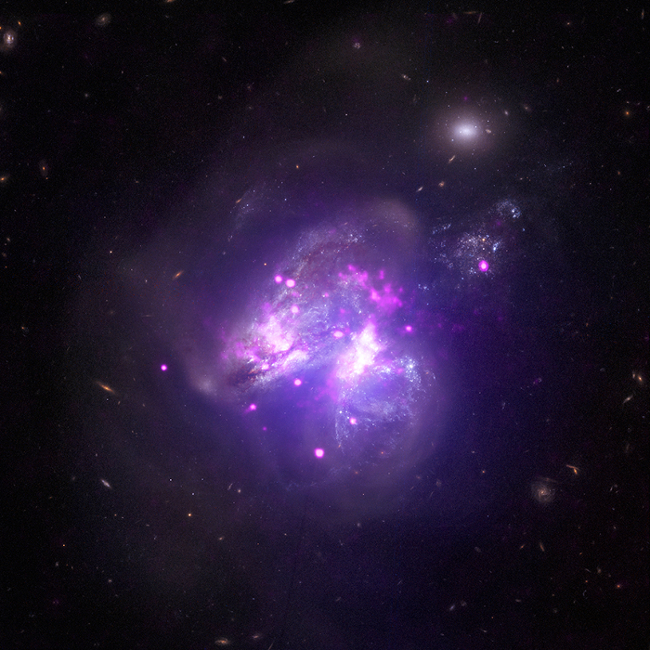
ULX factory
 Credit: X-ray: NASA/CXC/Univ of Crete/K. Anastasopoulou et al, NASA/NuSTAR/GSFC/A. Ptak et al; Optical: NASA/STScI
Credit: X-ray: NASA/CXC/Univ of Crete/K. Anastasopoulou et al, NASA/NuSTAR/GSFC/A. Ptak et al; Optical: NASA/STScI
Rapid star formation in galaxies can be driven by collisions between neighboring galaxies. These collisions can trigger shocks in the ambient gas in the colliding galaxies, causing some gas clouds to rapidly compress into stars. One of the most active star forming galaxies relatively close to the Milky Way is a galaxy called Arp 299, which forms the equivalent of between 10 to 100 solar-type stars per year. Arp 299 is really two galaxies, NGC 3690 and IC 694, which collided long ago, and this merger is most likely responsible for this high star formation rate. X-ray emission is a useful tracer of the entire history of star formation in a galaxy, providing views of heavily obscured, newly forming stars, and also providing a census of the compact objects (neutron stars and black holes) that the most massive stars have quickly evolved into. Arp 299 is very bright in X-rays. The image above shows a combined optical image of Arp 299 and X-ray emission from the Chandra X-ray Observatory in pink, and high-energy X-rays from the NuSTAR high-energy X-ray telescope in blue. The X-ray data show a large number of very powerful, so-called "ultra-luminous X-ray sources" in Arp 299. These ULXs are brighter in X-rays than most "normal" (non-explosive) X-ray emitting objects found in galaxies. Typically a galaxy may host one or two ULX sources - Arp 299 has 20. Based on their association with regions of strong star formation, these ultra-luminous sources in Arp 299 are believed to be accreting high-mass X-ray binary star systems composed of a normal, massive stars (having a mass of more than 10 times the mass of the Sun) and a compact accreting object (probably a black hole) which is the descendent of a more-massive star that ran through its nuclear evolution and exploded. These X-ray observations also show that supermassive, deeply embedded black holes lie at the centers of NGC 3690 and IC 694.
Published: September 4, 2017
<
HEA Dictionary ● Archive
● Search HEAPOW
● Other Languages
● HEAPOW on Facebook
● Download all Images
● Education ● HEAD
>

Each week the HEASARC
brings you new, exciting and beautiful images from X-ray and Gamma ray
astronomy. Check back each week and be sure to check out the HEAPOW archive!
Page Author: Dr. Michael F. Corcoran
Last modified Tuesday, 27-Feb-2024 10:06:36 EST


